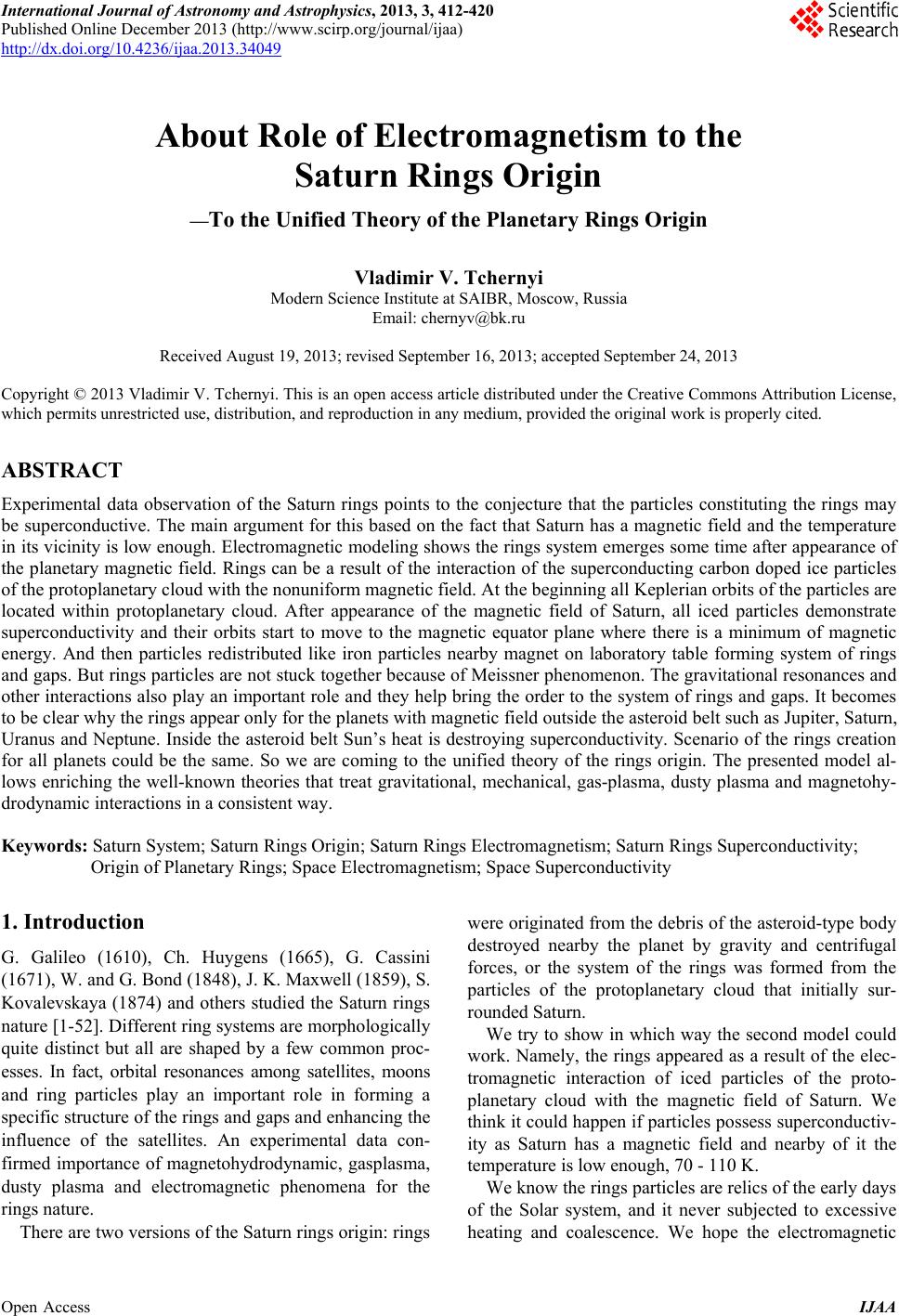 International Journal of Astronomy and Astrophysics, 2013, 3, 412-420 Published Online December 2013 (http://www.scirp.org/journal/ijaa) http://dx.doi.org/10.4236/ijaa.2013.34049 Open Access IJAA About Role of Electromagnetism to the Saturn Rings Origin —To the Unified Theory of the Planetary Rings Origin Vladimir V. Tchernyi Modern Science Institute at SAIBR, Moscow, Russia Email: chernyv@bk.ru Received August 19, 2013; revised September 16, 2013; accepted September 24, 2013 Copyright © 2013 Vladimir V. Tchernyi. This is an open access article distributed under the Creative Commons Attribution License, which permits unrestricted use, distribution, and reproduction in any medium, provided the original work is properly cited. ABSTRACT Experimental data observation of the Saturn rings points to the conjecture that the particles constituting the rings may be superconductive. The main argument for this based on the fact that Saturn has a magnetic field and the temperature in its vicinity is low enough. Electromagnetic modeling shows the rings system emerges some time after appearance of the planetary magnetic field. Rings can be a result of the interaction of the superconducting carbon doped ice particles of the protoplanetary cloud with the nonuniform magnetic field. At the beginning all Keplerian orbits of the particles are located within protoplanetary cloud. After appearance of the magnetic field of Saturn, all iced particles demonstrate superconductivity and their orbits start to move to the magnetic equator plane where there is a minimum of magnetic energy. And then particles redistributed like iron particles nearby magnet on laboratory table forming system of rings and gaps. But rings particles are not stuck together because of Meissner phenomenon. The gravitational resonances and other interactions also play an important role and they help bring the order to the system of rings and gaps. It becomes to be clear why the rings appear only for the planets with magnetic field outside the asteroid belt such as Jupiter, Saturn, Uranus and Neptune. Inside the asteroid belt Sun’s heat is destroying superconductivity. Scenario of the rings creation for all planets could be the same. So we are coming to the unified theory of the rings origin. The presented model al- lows enriching the well-known theories that treat gravitational, mechanical, gas-plasma, dusty plasma and magnetohy- drodynamic interactions in a consistent way. Keywords: Saturn System; Saturn Rings Origin; Saturn Rings Electromagnetism; Saturn Rings Superconductivity; Origin of Planetary Rings; Space Electromagnetism; Space Superconductivity 1. Introduction G. Galileo (1610), Ch. Huygens (1665), G. Cassini (1671), W. and G. Bond (1848), J. K. Maxwell (1859), S. Kovalevskaya (1874) and others studied the Saturn rings nature [1-52]. Different ring systems are morphologically quite distinct but all are shaped by a few common proc- esses. In fact, orbital resonances among satellites, moons and ring particles play an important role in forming a specific structure of the rings and gaps and enhancing the influence of the satellites. An experimental data con- firmed importance of magnetohydrodynamic, gasplasma, dusty plasma and electromagnetic phenomena for the rings nature. There are two versions of the Saturn rings origin: rings were originated from the debris of the asteroid-type body destroyed nearby the planet by gravity and centrifugal forces, or the system of the rings was formed from the particles of the protoplanetary cloud that initially sur- rounded Saturn. We try to show in which way the second model could work. Namely, the rings appeared as a result of the elec- tromagnetic interaction of iced particles of the proto- planetary cloud with the magnetic field of Saturn. We think it could happen if particles possess superconductiv- ity as Saturn has a magnetic field and nearby of it the temperature is low enough, 70 - 110 K. We know the rings particles are relics of the early days of the Solar system, and it never subjected to excessive heating and coalescence. We hope the electromagnetic 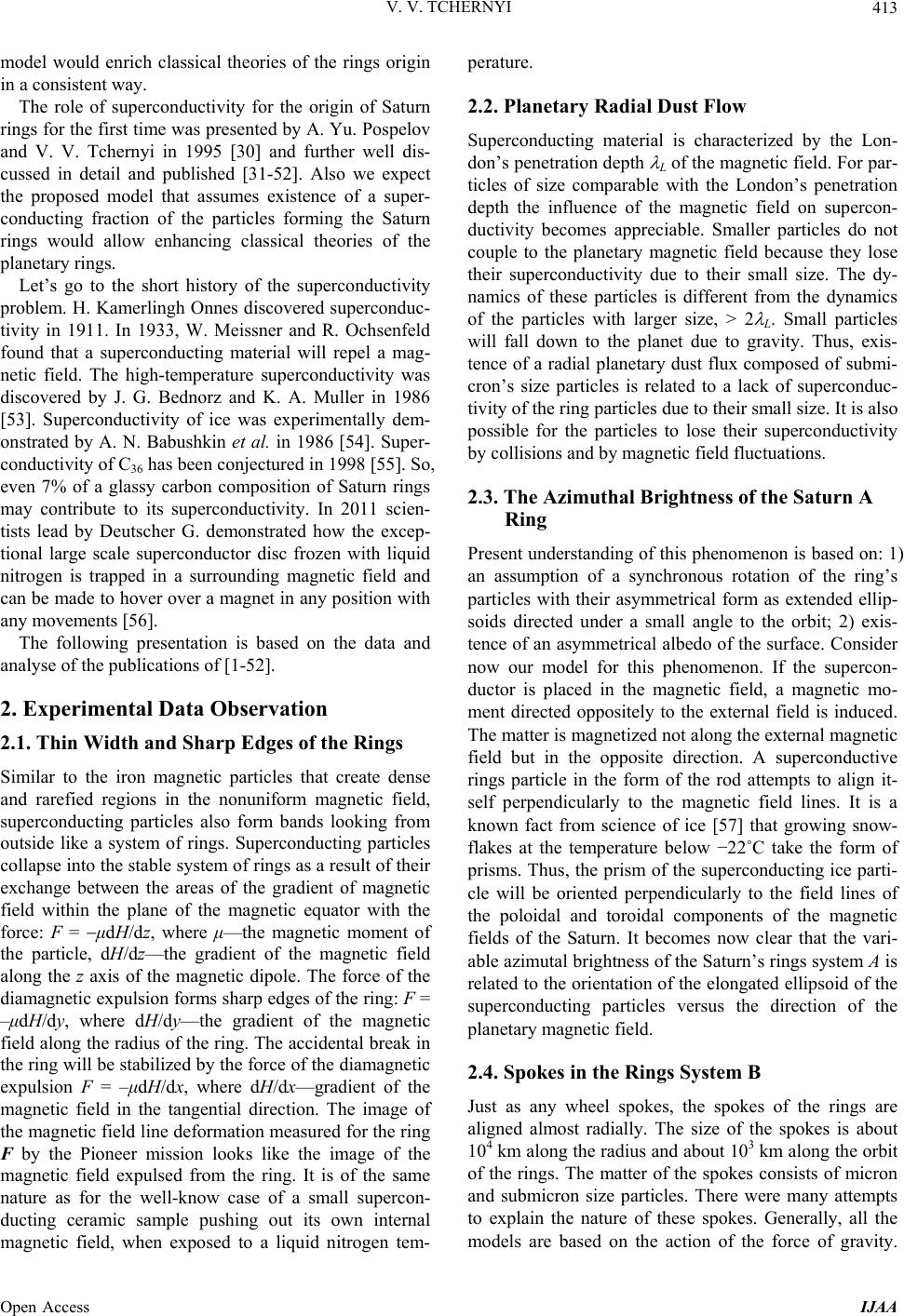 V. V. TCHERNYI 413 model would enrich classical theories of the rings origin in a consistent way. The role of superconductivity for the origin of Saturn rings for the first time was presented by A. Yu. Pospelov and V. V. Tchernyi in 1995 [30] and further well dis- cussed in detail and published [31-52]. Also we expect the proposed model that assumes existence of a super- conducting fraction of the particles forming the Saturn rings would allow enhancing classical theories of the planetary rings. Let’s go to the short history of the superconductivity problem. H. Kamerlingh Onnes discovered superconduc- tivity in 1911. In 1933, W. Meissner and R. Ochsenfeld found that a superconducting material will repel a mag- netic field. The high-temperature superconductivity was discovered by J. G. Bednorz and K. A. Muller in 1986 [53]. Superconductivity of ice was experimentally dem- onstrated by A. N. Babushkin et al. in 1986 [54]. Super- conductivity of C36 has been conjectured in 1998 [55]. So, even 7% of a glassy carbon composition of Saturn rings may contribute to its superconductivity. In 2011 scien- tists lead by Deutscher G. demonstrated how the excep- tional large scale superconductor disc frozen with liquid nitrogen is trapped in a surrounding magnetic field and can be made to hover over a magnet in any position with any movements [56]. The following presentation is based on the data and analyse of the publications of [1-52]. 2. Experimental Data Observation 2.1. Thin Width and Sharp Edges of the Rings Similar to the iron magnetic particles that create dense and rarefied regions in the nonuniform magnetic field, superconducting particles also form bands looking from outside like a system of rings. Superconducting particles collapse into the stable system of rings as a result of their exchange between the areas of the gradient of magnetic field within the plane of the magnetic equator with the force: F = μdH/dz, where μ—the magnetic moment of the particle, dH/dz—the gradient of the magnetic field along the z axis of the magnetic dipole. The force of the diamagnetic expulsion forms sharp edges of the ring: F = –μdH/dy, where dH/d y—the gradient of the magnetic field along the radius of the ring. The accidental break in the ring will be stabilized by the force of the diamagnetic expulsion F = –μdH/dx, where dH/dx—gradient of the magnetic field in the tangential direction. The image of the magnetic field line deformation measured for the ring F by the Pioneer mission looks like the image of the magnetic field expulsed from the ring. It is of the same nature as for the well-know case of a small supercon- ducting ceramic sample pushing out its own internal magnetic field, when exposed to a liquid nitrogen tem- perature. 2.2. Planetary Radial Dust Flow Superconducting material is characterized by the Lon- don’s penetration depth L of the magnetic field. For par- ticles of size comparable with the London’s penetration depth the influence of the magnetic field on supercon- ductivity becomes appreciable. Smaller particles do not couple to the planetary magnetic field because they lose their superconductivity due to their small size. The dy- namics of these particles is different from the dynamics of the particles with larger size, > 2 L. Small particles will fall down to the planet due to gravity. Thus, exis- tence of a radial planetary dust flux composed of submi- cron’s size particles is related to a lack of superconduc- tivity of the ring particles due to their small size. It is also possible for the particles to lose their superconductivity by collisions and by magnetic field fluctuations. 2.3. The Azimuthal Brightness of the Saturn A Ring Present understanding of this phenomenon is based on: 1) an assumption of a synchronous rotation of the ring’s particles with their asymmetrical form as extended ellip- soids directed under a small angle to the orbit; 2) exis- tence of an asymmetrical albedo of the surface. Consider now our model for this phenomenon. If the supercon- ductor is placed in the magnetic field, a magnetic mo- ment directed oppositely to the external field is induced. The matter is magnetized not along the external magnetic field but in the opposite direction. A superconductive rings particle in the form of the rod attempts to align it- self perpendicularly to the magnetic field lines. It is a known fact from science of ice [57] that growing snow- flakes at the temperature below −22˚C take the form of prisms. Thus, the prism of the superconducting ice parti- cle will be oriented perpendicularly to the field lines of the poloidal and toroidal components of the magnetic fields of the Saturn. It becomes now clear that the vari- able azimutal brightness of the Saturn’s rings system A is related to the orientation of the elongated ellipsoid of the superconducting particles versus the direction of the planetary magnetic field. 2.4. Spokes in the Rings System B Just as any wheel spokes, the spokes of the rings are aligned almost radially. The size of the spokes is about 104 km along the radius and about 103 km along the orbit of the rings. The matter of the spokes consists of micron and submicron size particles. There were many attempts to explain the nature of these spokes. Generally, all the models are based on the action of the force of gravity. Open Access IJAA 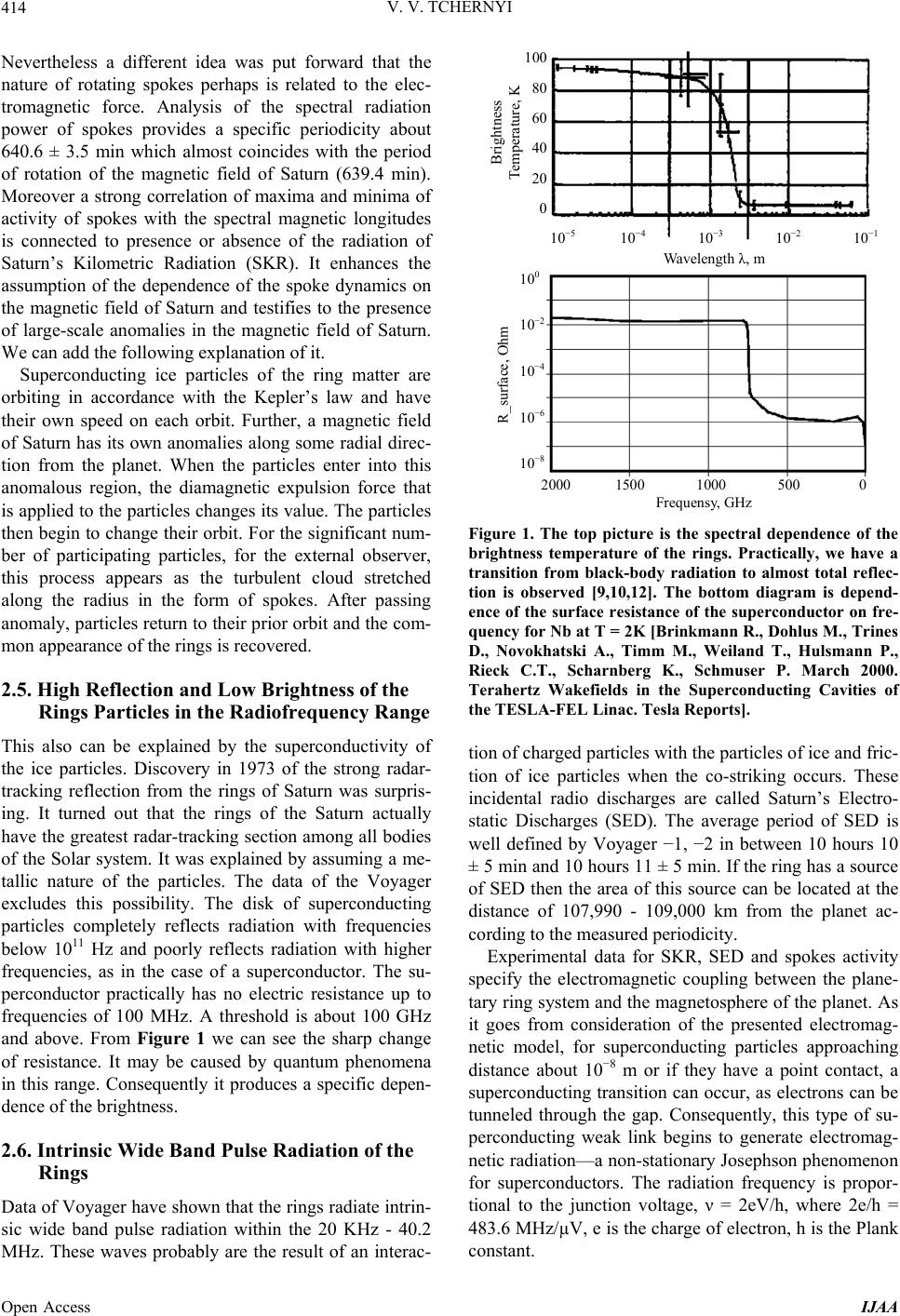 V. V. TCHERNYI 414 Nevertheless a different idea was put forward that the nature of rotating spokes perhaps is related to the elec- tromagnetic force. Analysis of the spectral radiation power of spokes provides a specific periodicity about 640.6 ± 3.5 min which almost coincides with the period of rotation of the magnetic field of Saturn (639.4 min). Moreover a strong correlation of maxima and minima of activity of spokes with the spectral magnetic longitudes is connected to presence or absence of the radiation of Saturn’s Kilometric Radiation (SKR). It enhances the assumption of the dependence of the spoke dynamics on the magnetic field of Saturn and testifies to the presence of large-scale anomalies in the magnetic field of Saturn. We can add the following explanation of it. Superconducting ice particles of the ring matter are orbiting in accordance with the Kepler’s law and have their own speed on each orbit. Further, a magnetic field of Saturn has its own anomalies along some radial direc- tion from the planet. When the particles enter into this anomalous region, the diamagnetic expulsion force that is applied to the particles changes its value. The particles then begin to change their orbit. For the significant num- ber of participating particles, for the external observer, this process appears as the turbulent cloud stretched along the radius in the form of spokes. After passing anomaly, particles return to their prior orbit and the com- mon appearance of the rings is recovered. 2.5. High Reflection and Low Brightness of the Rings Particles in the Radiofrequency Range This also can be explained by the superconductivity of the ice particles. Discovery in 1973 of the strong radar- tracking reflection from the rings of Saturn was surpris- ing. It turned out that the rings of the Saturn actually have the greatest radar-tracking section among all bodies of the Solar system. It was explained by assuming a me- tallic nature of the particles. The data of the Voyager excludes this possibility. The disk of superconducting particles completely reflects radiation with frequencies below 1011 Hz and poorly reflects radiation with higher frequencies, as in the case of a superconductor. The su- perconductor practically has no electric resistance up to frequencies of 100 MHz. A threshold is about 100 GHz and above. From Figure 1 we can see the sharp change of resistance. It may be caused by quantum phenomena in this range. Consequently it produces a specific depen- dence of the brightness. 2.6. Intrinsic Wide Band Pulse Radiation of the Rings Data of Voyager have shown that the rings radiate intrin- sic wide band pulse radiation within the 20 KHz - 40.2 MHz. These waves probably are the result of an interac- 10−5 10 −4 10 −3 10 −2 10 −1 Wavelen gt h λ, m 100 80 60 40 20 0 Brightness Temperature, K R_surface, Ohm 10 0 10 −2 10 −4 10 −6 10 −8 2000 1500 1000 500 0 Frequensy, GHz Figure 1. The top picture is the spectral dependence of the brightness temperature of the rings. Practically, we have a transition from black-body radiation to almost total reflec- tion is observed [9,10,12]. The bottom diagram is depend- ence of the surface resistance of the superconductor on fre- quency for Nb at T = 2K [Brinkmann R., Dohlus M., Tr ines D., Novokhatski A., Timm M., Weiland T., Hulsmann P., Rieck C.T., Scharnberg K., Schmuser P. March 2000. Terahertz Wakefields in the Superconducting Cavities of the TESLA-FEL Linac. Tesla Reports]. tion of charged particles with the particles of ice and fric- tion of ice particles when the co-striking occurs. These incidental radio discharges are called Saturn’s Electro- static Discharges (SED). The average period of SED is well defined by Voyager −1, −2 in between 10 hours 10 ± 5 min and 10 hours 11 ± 5 min. If the ring has a source of SED then the area of this source can be located at the distance of 107,990 - 109,000 km from the planet ac- cording to the measured periodicity. Experimental data for SKR, SED and spokes activity specify the electromagnetic coupling between the plane- tary ring system and the magnetosphere of the planet. As it goes from consideration of the presented electromag- netic model, for superconducting particles approaching distance about 10−8 m or if they have a point contact, a superconducting transition can occur, as electrons can be tunneled through the gap. Consequently, this type of su- perconducting weak link begins to generate electromag- netic radiation—a non-stationary Josephson phenomenon for superconductors. The radiation frequency is propor- tional to the junction voltage, ν = 2eV/h, where 2e/h = 483.6 MHz/µV, e is the charge of electron, h is the Plank constant. Open Access IJAA 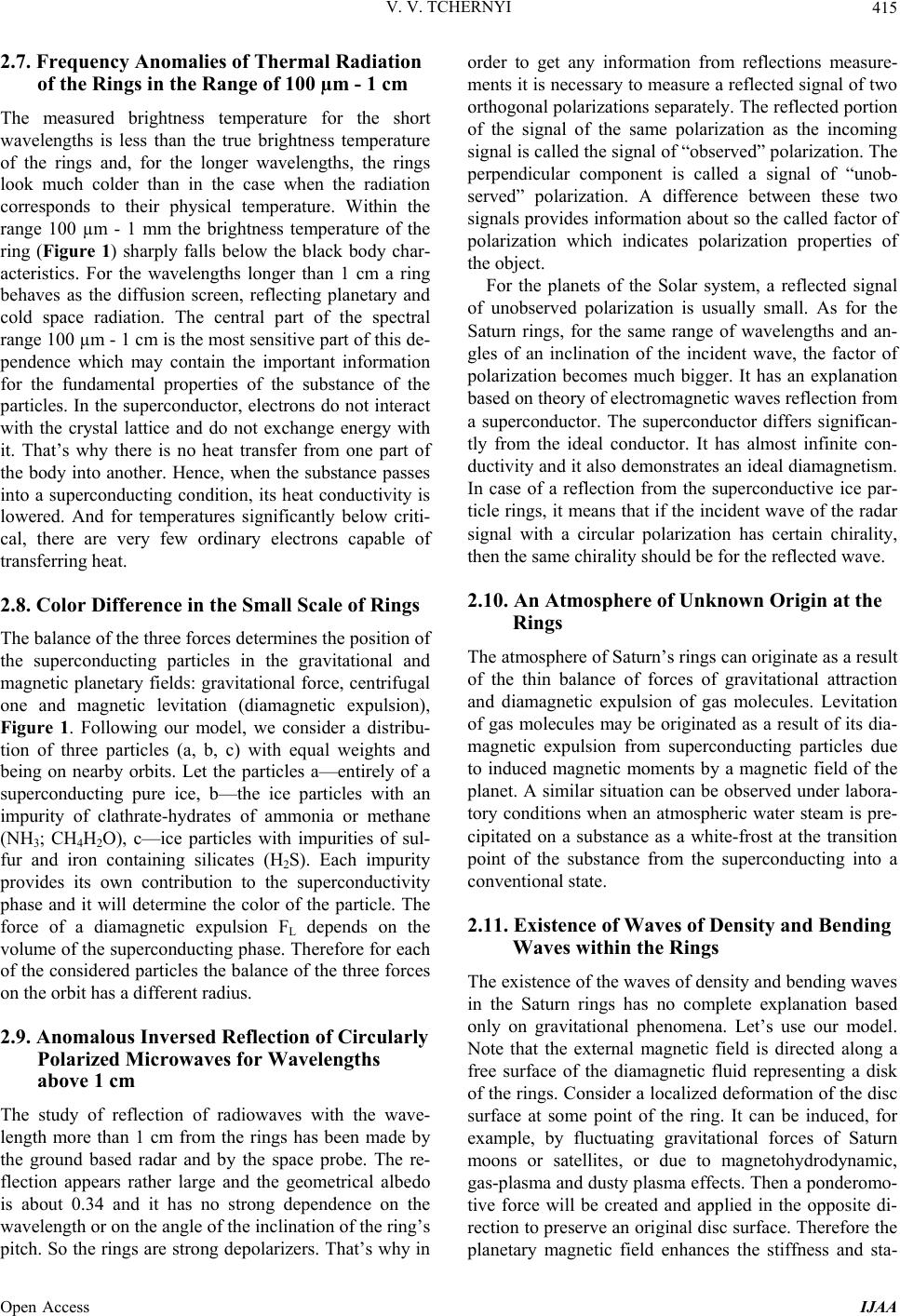 V. V. TCHERNYI 415 2.7. Frequency Anomalies of Thermal Radiation of the Rings in the Range of 100 µm - 1 cm The measured brightness temperature for the short wavelengths is less than the true brightness temperature of the rings and, for the longer wavelengths, the rings look much colder than in the case when the radiation corresponds to their physical temperature. Within the range 100 µm - 1 mm the brightness temperature of the ring (Figure 1) sharply falls below the black body char- acteristics. For the wavelengths longer than 1 cm a ring behaves as the diffusion screen, reflecting planetary and cold space radiation. The central part of the spectral range 100 µm - 1 cm is the most sensitive part of this de- pendence which may contain the important information for the fundamental properties of the substance of the particles. In the superconductor, electrons do not interact with the crystal lattice and do not exchange energy with it. That’s why there is no heat transfer from one part of the body into another. Hence, when the substance passes into a superconducting condition, its heat conductivity is lowered. And for temperatures significantly below criti- cal, there are very few ordinary electrons capable of transferring heat. 2.8. Color Difference in the Small Scale of Rings The balance of the three forces determines the position of the superconducting particles in the gravitational and magnetic planetary fields: gravitational force, centrifugal one and magnetic levitation (diamagnetic expulsion), Figure 1. Following our model, we consider a distribu- tion of three particles (a, b, c) with equal weights and being on nearby orbits. Let the particles a—entirely of a superconducting pure ice, b—the ice particles with an impurity of clathrate-hydrates of ammonia or methane (NH3; CH4H2O), c—ice particles with impurities of sul- fur and iron containing silicates (H2S). Each impurity provides its own contribution to the superconductivity phase and it will determine the color of the particle. The force of a diamagnetic expulsion FL depends on the volume of the superconducting phase. Therefore for each of the considered particles the balance of the three forces on the orbit has a different radius. 2.9. Anomalous Inversed Reflection of Circularly Polarized Microwaves for Wavelengths above 1 cm The study of reflection of radiowaves with the wave- length more than 1 cm from the rings has been made by the ground based radar and by the space probe. The re- flection appears rather large and the geometrical albedo is about 0.34 and it has no strong dependence on the wavelength or on the angle of the inclination of the ring’s pitch. So the rings are strong depolarizers. That’s why in order to get any information from reflections measure- ments it is necessary to measure a reflected signal of two orthogonal polarizations separately. The reflected portion of the signal of the same polarization as the incoming signal is called the signal of “observed” polarization. The perpendicular component is called a signal of “unob- served” polarization. A difference between these two signals provides information about so the called factor of polarization which indicates polarization properties of the object. For the planets of the Solar system, a reflected signal of unobserved polarization is usually small. As for the Saturn rings, for the same range of wavelengths and an- gles of an inclination of the incident wave, the factor of polarization becomes much bigger. It has an explanation based on theory of electromagnetic waves reflection from a superconductor. The superconductor differs significan- tly from the ideal conductor. It has almost infinite con- ductivity and it also demonstrates an ideal diamagnetism. In case of a reflection from the superconductive ice par- ticle rings, it means that if the incident wave of the radar signal with a circular polarization has certain chirality, then the same chirality should be for the reflected wave. 2.10. An Atmosphere of Unknown Origin at the Rings The atmosphere of Saturn’s rings can originate as a result of the thin balance of forces of gravitational attraction and diamagnetic expulsion of gas molecules. Levitation of gas molecules may be originated as a result of its dia- magnetic expulsion from superconducting particles due to induced magnetic moments by a magnetic field of the planet. A similar situation can be observed under labora- tory conditions when an atmospheric water steam is pre- cipitated on a substance as a white-frost at the transition point of the substance from the superconducting into a conventional state. 2.11. Existence of Waves of Density and Bending Waves within the Rings The existence of the waves of density and bending waves in the Saturn rings has no complete explanation based only on gravitational phenomena. Let’s use our model. Note that the external magnetic field is directed along a free surface of the diamagnetic fluid representing a disk of the rings. Consider a localized deformation of the disc surface at some point of the ring. It can be induced, for example, by fluctuating gravitational forces of Saturn moons or satellites, or due to magnetohydrodynamic, gas-plasma and dusty plasma effects. Then a ponderomo- tive force will be created and applied in the opposite di- rection to preserve an original disc surface. Therefore the planetary magnetic field enhances the stiffness and sta- Open Access IJAA 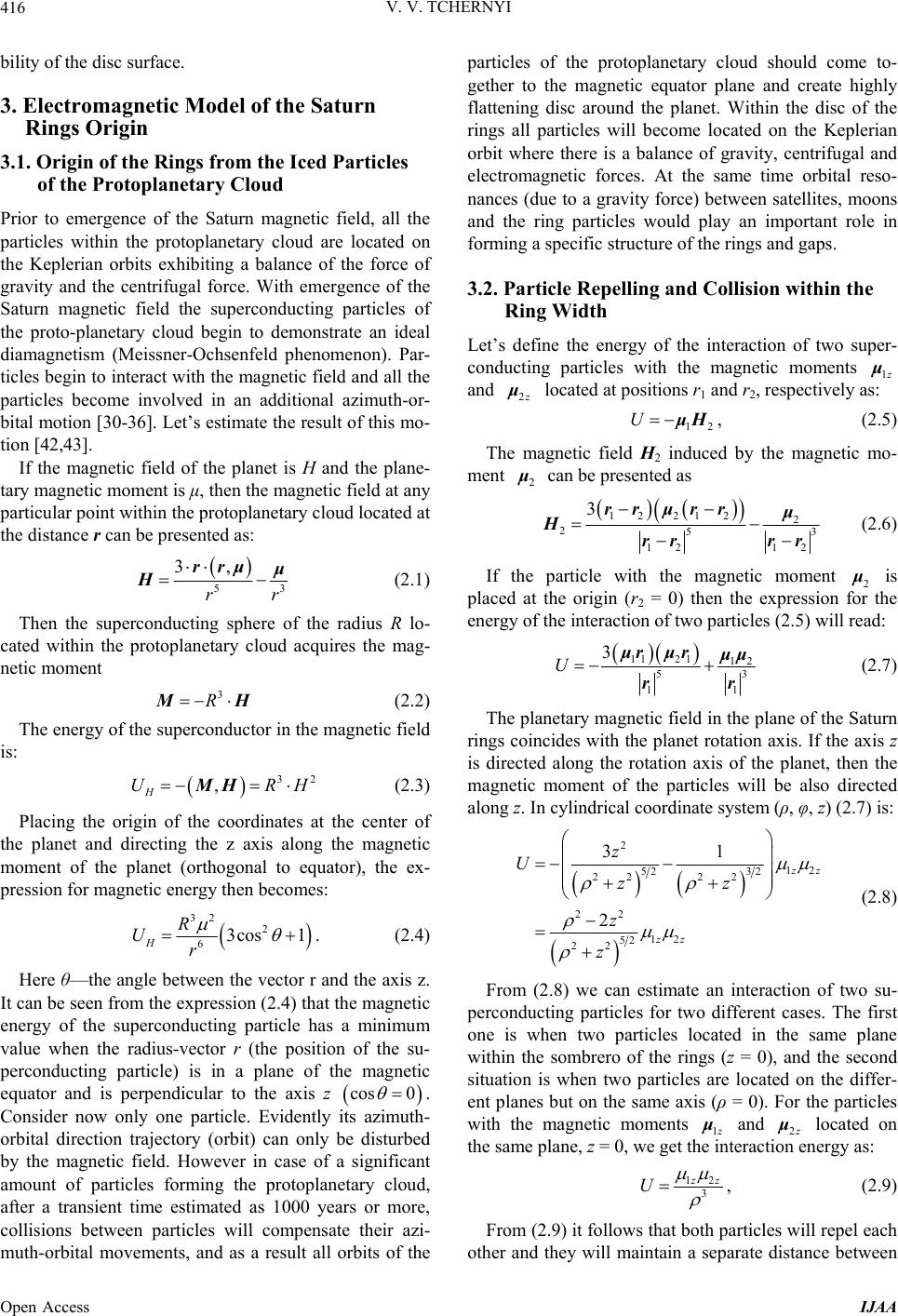 V. V. TCHERNYI 416 bility of the disc surface. 3. Electromagnetic Model of the Saturn Rings Origin 3.1. Origin of the Rings from the Iced Particles of the Protoplanetary Cloud Prior to emergence of the Saturn magnetic field, all the particles within the protoplanetary cloud are located on the Keplerian orbits exhibiting a balance of the force of gravity and the centrifugal force. With emergence of the Saturn magnetic field the superconducting particles of the proto-planetary cloud begin to demonstrate an ideal diamagnetism (Meissner-Ochsenfeld phenomenon). Par- ticles begin to interact with the magnetic field and all the particles become involved in an additional azimuth-or- bital motion [30-36]. Let’s estimate the result of this mo- tion [42,43]. If the magnetic field of the planet is H and the plane- tary magnetic moment is μ, then the magnetic field at any particular point within the protoplanetary cloud located at the distance r can be presented as: 5 3, rr rrμ 3 H (2.1) Then the superconducting sphere of the radius R lo- cated within the protoplanetary cloud acquires the mag- netic moment 3 R MH 2 RH (2.2) The energy of the superconductor in the magnetic field is: 3 , H U MH (2.3) Placing the origin of the coordinates at the center of the planet and directing the z axis along the magnetic moment of the planet (orthogonal to equator), the ex- pression for magnetic energy then becomes: 32 2 63cos 1 H R Ur . (2.4) Here θ—the angle between the vector r and the axis z. It can be seen from the expression (2.4) that the magnetic energy of the superconducting particle has a minimum value when the radius-vector r (the position of the su- perconducting particle) is in a plane of the magnetic equator and is perpendicular to the axis z cos 0 . Consider now only one particle. Evidently its azimuth- orbital direction trajectory (orbit) can only be disturbed by the magnetic field. However in case of a significant amount of particles forming the protoplanetary cloud, after a transient time estimated as 1000 years or more, collisions between particles will compensate their azi- muth-orbital movements, and as a result all orbits of the particles of the protoplanetary cloud should come to- gether to the magnetic equator plane and create highly flattening disc around the planet. Within the disc of the rings all particles will become located on the Keplerian orbit where there is a balance of gravity, centrifugal and electromagnetic forces. At the same time orbital reso- nances (due to a gravity force) between satellites, moons and the ring particles would play an important role in forming a specific structure of the rings and gaps. 3.2. Particle Repelling and Collision within the Ring Width Let’s define the energy of the interaction of two super- conducting particles with the magnetic moments 1 and 2 located at positions r1 and r2, respectively as: 12 U μ , (2.5) The magnetic field H2 induced by the magnetic mo- ment 2 can be presented as 12 2122 253 12 12 3 rr μrr μ H rr rr (2.6) If the particle with the magnetic moment 2 is placed at the origin (r2 = 0) then the expression for the energy of the interaction of two particles (2.5) will read: 11 2112 5 11 3 U μrμrμ 3 rr (2.7) The planetary magnetic field in the plane of the Saturn rings coincides with the planet rotation axis. If the axis z is directed along the rotation axis of the planet, then the magnetic moment of the particles will be also directed along z. In cylindrical coordinate system (ρ, φ, z) (2.7) is: 2 12 52 32 22 22 22 12 52 22 31 2 z zz z U zz z z (2.8) From (2.8) we can estimate an interaction of two su- perconducting particles for two different cases. The first one is when two particles located in the same plane within the sombrero of the rings (z = 0), and the second situation is when two particles are located on the differ- ent planes but on the same axis (ρ = 0). For the particles with the magnetic moments 1 and 2 located on the same plane, z = 0, we get the interaction energy as: 12 3 z U , (2.9) From (2.9) it follows that both particles will repel each other and they will maintain a separate distance between Open Access IJAA 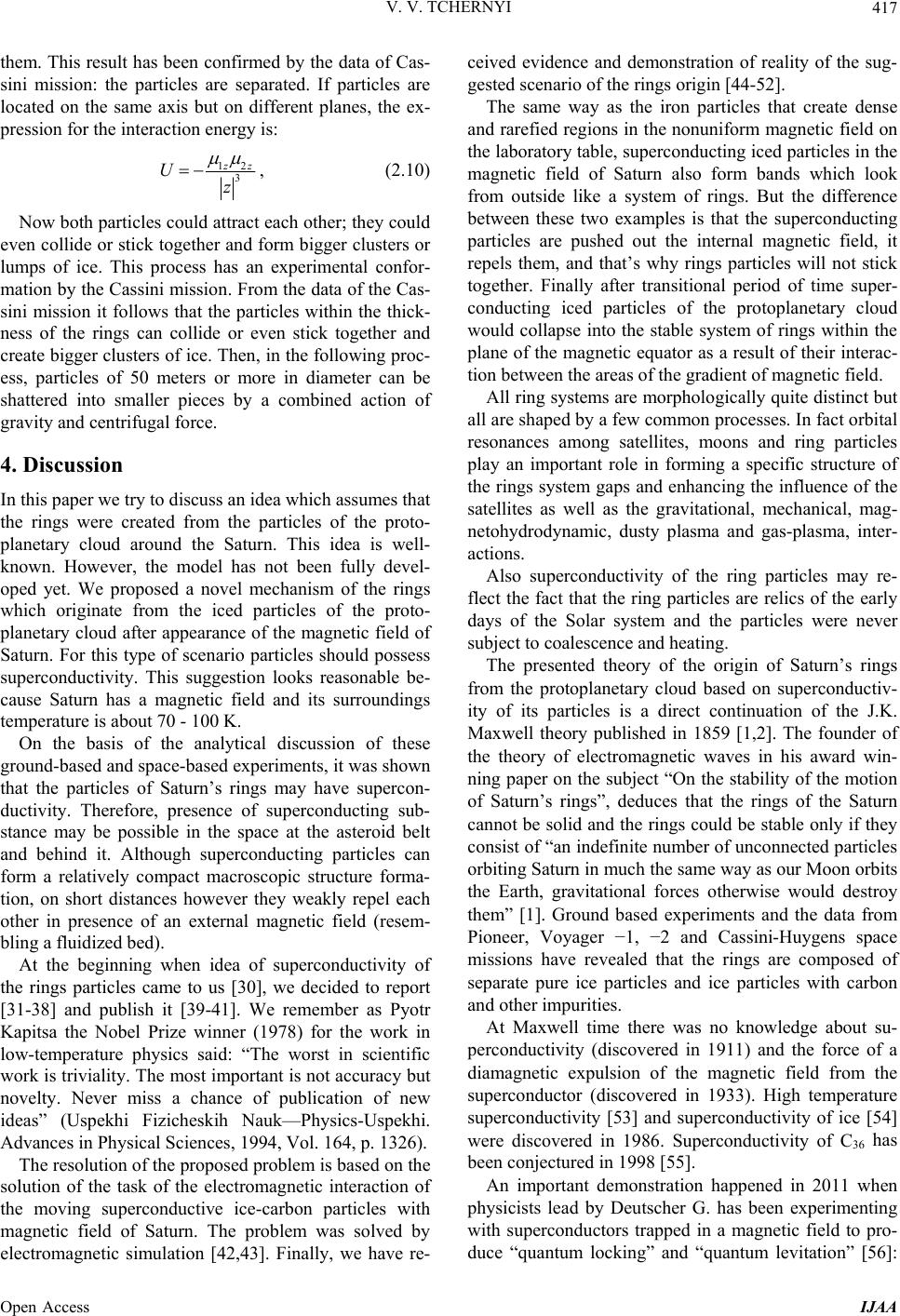 V. V. TCHERNYI 417 them. This result has been confirmed by the data of Cas- sini mission: the particles are separated. If particles are located on the same axis but on different planes, the ex- pression for the interaction energy is: 12 3 z U z , (2.10) Now both particles could attract each other; they could even collide or stick together and form bigger clusters or lumps of ice. This process has an experimental confor- mation by the Cassini mission. From the data of the Cas- sini mission it follows that the particles within the thick- ness of the rings can collide or even stick together and create bigger clusters of ice. Then, in the following proc- ess, particles of 50 meters or more in diameter can be shattered into smaller pieces by a combined action of gravity and centrifugal force. 4. Discussion In this paper we try to discuss an idea which assumes that the rings were created from the particles of the proto- planetary cloud around the Saturn. This idea is well- known. However, the model has not been fully devel- oped yet. We proposed a novel mechanism of the rings which originate from the iced particles of the proto- planetary cloud after appearance of the magnetic field of Saturn. For this type of scenario particles should possess superconductivity. This suggestion looks reasonable be- cause Saturn has a magnetic field and its surroundings temperature is about 70 - 100 K. On the basis of the analytical discussion of these ground-based and space-based experiments, it was shown that the particles of Saturn’s rings may have supercon- ductivity. Therefore, presence of superconducting sub- stance may be possible in the space at the asteroid belt and behind it. Although superconducting particles can form a relatively compact macroscopic structure forma- tion, on short distances however they weakly repel each other in presence of an external magnetic field (resem- bling a fluidized bed). At the beginning when idea of superconductivity of the rings particles came to us [30], we decided to report [31-38] and publish it [39-41]. We remember as Pyotr Kapitsa the Nobel Prize winner (1978) for the work in low-temperature physics said: “The worst in scientific work is triviality. The most important is not accuracy but novelty. Never miss a chance of publication of new ideas” (Uspekhi Fizicheskih Nauk—Physics-Uspekhi. Advances in Physical Sciences, 1994, Vol. 164, p. 1326). The resolution of the proposed problem is based on the solution of the task of the electromagnetic interaction of the moving superconductive ice-carbon particles with magnetic field of Saturn. The problem was solved by electromagnetic simulation [42,43]. Finally, we have re- ceived evidence and demonstration of reality of the sug- gested scenario of the rings origin [44-52]. The same way as the iron particles that create dense and rarefied regions in the nonuniform magnetic field on the laboratory table, superconducting iced particles in the magnetic field of Saturn also form bands which look from outside like a system of rings. But the difference between these two examples is that the superconducting particles are pushed out the internal magnetic field, it repels them, and that’s why rings particles will not stick together. Finally after transitional period of time super- conducting iced particles of the protoplanetary cloud would collapse into the stable system of rings within the plane of the magnetic equator as a result of their interac- tion between the areas of the gradient of magnetic field. All ring systems are morphologically quite distinct but all are shaped by a few common processes. In fact orbital resonances among satellites, moons and ring particles play an important role in forming a specific structure of the rings system gaps and enhancing the influence of the satellites as well as the gravitational, mechanical, mag- netohydrodynamic, dusty plasma and gas-plasma, inter- actions. Also superconductivity of the ring particles may re- flect the fact that the ring particles are relics of the early days of the Solar system and the particles were never subject to coalescence and heating. The presented theory of the origin of Saturn’s rings from the protoplanetary cloud based on superconductiv- ity of its particles is a direct continuation of the J.K. Maxwell theory published in 1859 [1,2]. The founder of the theory of electromagnetic waves in his award win- ning paper on the subject “On the stability of the motion of Saturn’s rings”, deduces that the rings of the Saturn cannot be solid and the rings could be stable only if they consist of “an indefinite number of unconnected particles orbiting Saturn in much the same way as our Moon orbits the Earth, gravitational forces otherwise would destroy them” [1]. Ground based experiments and the data from Pioneer, Voyager −1, −2 and Cassini-Huygens space missions have revealed that the rings are composed of separate pure ice particles and ice particles with carbon and other impurities. At Maxwell time there was no knowledge about su- perconductivity (discovered in 1911) and the force of a diamagnetic expulsion of the magnetic field from the superconductor (discovered in 1933). High temperature superconductivity [53] and superconductivity of ice [54] were discovered in 1986. Superconductivity of C36 has been conjectured in 1998 [55]. An important demonstration happened in 2011 when physicists lead by Deutscher G. has been experimenting with superconductors trapped in a magnetic field to pro- duce “quantum locking” and “quantum levitation” [56]: Open Access IJAA 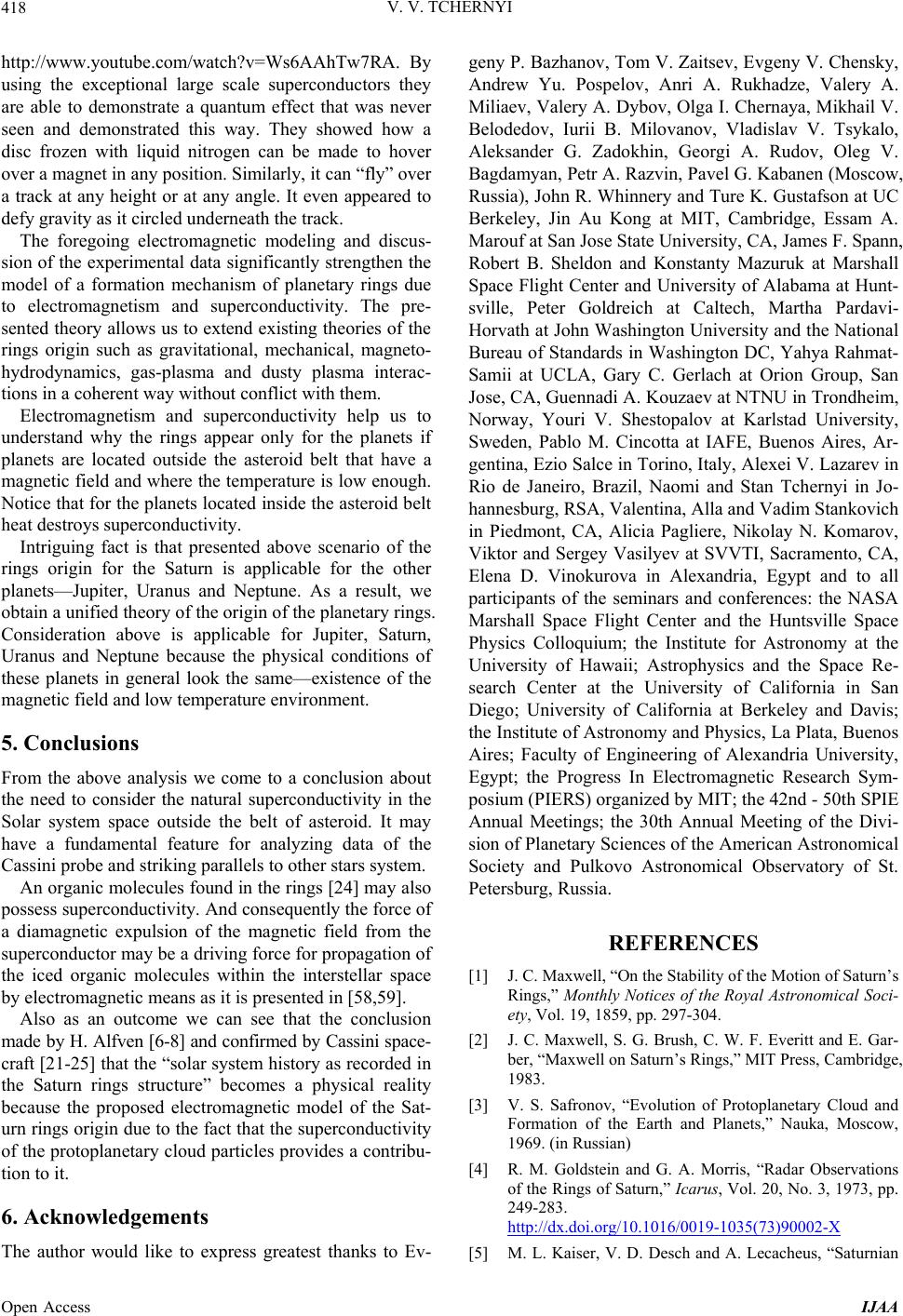 V. V. TCHERNYI 418 http://www.youtube.com/watch?v=Ws6AAhTw7RA. By using the exceptional large scale superconductors they are able to demonstrate a quantum effect that was never seen and demonstrated this way. They showed how a disc frozen with liquid nitrogen can be made to hover over a magnet in any position. Similarly, it can “fly” over a track at any height or at any angle. It even appeared to defy gravity as it circled underneath the track. The foregoing electromagnetic modeling and discus- sion of the experimental data significantly strengthen the model of a formation mechanism of planetary rings due to electromagnetism and superconductivity. The pre- sented theory allows us to extend existing theories of the rings origin such as gravitational, mechanical, magneto- hydrodynamics, gas-plasma and dusty plasma interac- tions in a coherent way without conflict with them. Electromagnetism and superconductivity help us to understand why the rings appear only for the planets if planets are located outside the asteroid belt that have a magnetic field and where the temperature is low enough. Notice that for the planets located inside the asteroid belt heat destroys superconductivity. Intriguing fact is that presented above scenario of the rings origin for the Saturn is applicable for the other planets—Jupiter, Uranus and Neptune. As a result, we obtain a unified theory of the origin of the planetary rings. Consideration above is applicable for Jupiter, Saturn, Uranus and Neptune because the physical conditions of these planets in general look the same—existence of the magnetic field and low temperature environment. 5. Conclusions From the above analysis we come to a conclusion about the need to consider the natural superconductivity in the Solar system space outside the belt of asteroid. It may have a fundamental feature for analyzing data of the Cassini probe and striking parallels to other stars system. An organic molecules found in the rings [24] may also possess superconductivity. And consequently the force of a diamagnetic expulsion of the magnetic field from the superconductor may be a driving force for propagation of the iced organic molecules within the interstellar space by electromagnetic means as it is presented in [58,59]. Also as an outcome we can see that the conclusion made by H. Alfven [6-8] and confirmed by Cassini space- craft [21-25] that the “solar system history as recorded in the Saturn rings structure” becomes a physical reality because the proposed electromagnetic model of the Sat- urn rings origin due to the fact that the superconductivity of the protoplanetary cloud particles provides a contribu- tion to it. 6. Acknowledgements The author would like to express greatest thanks to Ev- geny P. Bazhanov, Tom V. Zaitsev, Evgeny V. Chensky, Andrew Yu. Pospelov, Anri A. Rukhadze, Valery A. Miliaev, Valery A. Dybov, Olga I. Chernaya, Mikhail V. Belodedov, Iurii B. Milovanov, Vladislav V. Tsykalo, Aleksander G. Zadokhin, Georgi A. Rudov, Oleg V. Bagdamyan, Petr A. Razvin, Pavel G. Kabanen (Moscow, Russia), John R. Whinnery and Ture K. Gustafson at UC Berkeley, Jin Au Kong at MIT, Cambridge, Essam A. Marouf at San Jose State University, CA, James F. Spann, Robert B. Sheldon and Konstanty Mazuruk at Marshall Space Flight Center and University of Alabama at Hunt- sville, Peter Goldreich at Caltech, Martha Pardavi- Horvath at John Washington University and the National Bureau of Standards in Washington DC, Yahya Rahmat- Samii at UCLA, Gary C. Gerlach at Orion Group, San Jose, CA, Guennadi A. Kouzaev at NTNU in Trondheim, Norway, Youri V. Shestopalov at Karlstad University, Sweden, Pablo M. Cincotta at IAFE, Buenos Aires, Ar- gentina, Ezio Salce in Torino, Italy, Alexei V. Lazarev in Rio de Janeiro, Brazil, Naomi and Stan Tchernyi in Jo- hannesburg, RSA, Valentina, Alla and Vadim Stankovich in Piedmont, CA, Alicia Pagliere, Nikolay N. Komarov, Viktor and Sergey Vasilyev at SVVTI, Sacramento, CA, Elena D. Vinokurova in Alexandria, Egypt and to all participants of the seminars and conferences: the NASA Marshall Space Flight Center and the Huntsville Space Physics Colloquium; the Institute for Astronomy at the University of Hawaii; Astrophysics and the Space Re- search Center at the University of California in San Diego; University of California at Berkeley and Davis; the Institute of Astronomy and Physics, La Plata, Buenos Aires; Faculty of Engineering of Alexandria University, Egypt; the Progress In Electromagnetic Research Sym- posium (PIERS) organized by MIT; the 42nd - 50th SPIE Annual Meetings; the 30th Annual Meeting of the Divi- sion of Planetary Sciences of the American Astronomical Society and Pulkovo Astronomical Observatory of St. Petersburg, Russia. REFERENCES [1] J. C. Maxwell, “On the Stability of the Motion of Saturn’s Rings,” Monthly Notices of the Royal Astronomical Soci- ety, Vol. 19, 1859, pp. 297-304. [2] J. C. Maxwell, S. G. Brush, C. W. F. Everitt and E. Gar- ber, “Maxwell on Saturn’s Rings,” MIT Press, Cambridge, 1983. [3] V. S. Safronov, “Evolution of Protoplanetary Cloud and Formation of the Earth and Planets,” Nauka, Moscow, 1969. (in Russian) [4] R. M. Goldstein and G. A. Morris, “Radar Observations of the Rings of Saturn,” Icarus, Vol. 20, No. 3, 1973, pp. 249-283. http://dx.doi.org/10.1016/0019-1035(73)90002-X [5] M. L. Kaiser, V. D. Desch and A. Lecacheus, “Saturnian Open Access IJAA 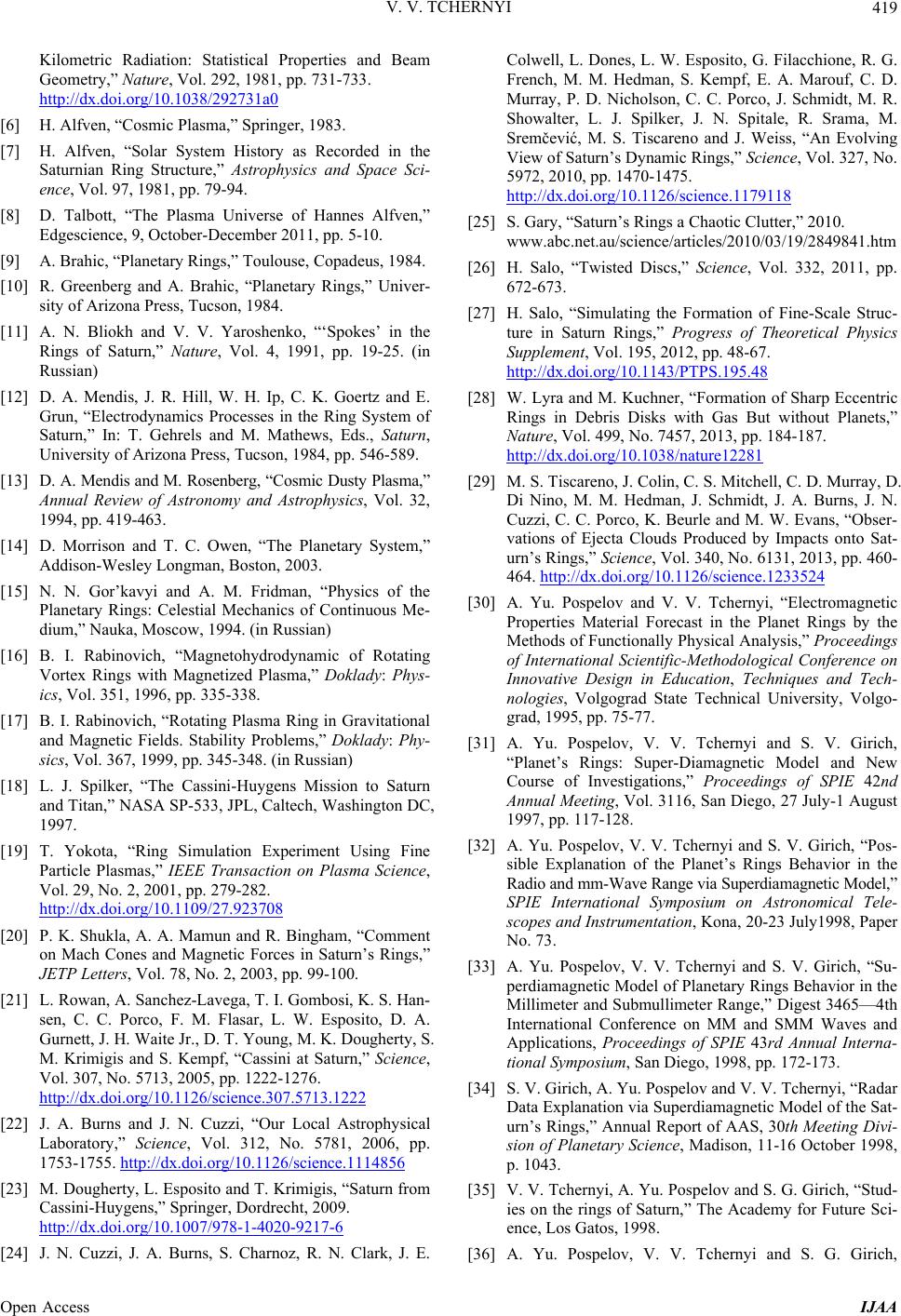 V. V. TCHERNYI 419 Kilometric Radiation: Statistical Properties and Beam Geometry,” Nature, Vol. 292, 1981, pp. 731-733. http://dx.doi.org/10.1038/292731a0 [6] H. Alfven, “Cosmic Plasma,” Springer, 1983. [7] H. Alfven, “Solar System History as Recorded in the Saturnian Ring Structure,” Astrophysics and Space Sci- ence, Vol. 97, 1981, pp. 79-94. [8] D. Talbott, “The Plasma Universe of Hannes Alfven,” Edgescience, 9, October-December 2011, pp. 5-10. [9] A. Brahic, “Planetary Rings,” Toulouse, Copadeus, 1984. [10] R. Greenberg and A. Brahic, “Planetary Rings,” Univer- sity of Arizona Press, Tucson, 1984. [11] A. N. Bliokh and V. V. Yaroshenko, “‘Spokes’ in the Rings of Saturn,” Nature, Vol. 4, 1991, pp. 19-25. (in Russian) [12] D. A. Mendis, J. R. Hill, W. H. Ip, C. K. Goertz and E. Grun, “Electrodynamics Processes in the Ring System of Saturn,” In: T. Gehrels and M. Mathews, Eds., Saturn, University of Arizona Press, Tucson, 1984, pp. 546-589. [13] D. A. Mendis and M. Rosenberg, “Cosmic Dusty Plasma,” Annual Review of Astronomy and Astrophysics, Vol. 32, 1994, pp. 419-463. [14] D. Morrison and T. C. Owen, “The Planetary System,” Addison-Wesley Longman, Boston, 2003. [15] N. N. Gor’kavyi and A. M. Fridman, “Physics of the Planetary Rings: Celestial Mechanics of Continuous Me- dium,” Nauka, Moscow, 1994. (in Russian) [16] B. I. Rabinovich, “Magnetohydrodynamic of Rotating Vortex Rings with Magnetized Plasma,” Doklady: Phys- ics, Vol. 351, 1996, pp. 335-338. [17] B. I. Rabinovich, “Rotating Plasma Ring in Gravitational and Magnetic Fields. Stability Problems,” Doklady: Phy- sics, Vol. 367, 1999, pp. 345-348. (in Russian) [18] L. J. Spilker, “The Cassini-Huygens Mission to Saturn and Titan,” NASA SP-533, JPL, Caltech, Washington DC, 1997. [19] T. Yokota, “Ring Simulation Experiment Using Fine Particle Plasmas,” IEEE Transaction on Plasma Science, Vol. 29, No. 2, 2001, pp. 279-282. http://dx.doi.org/10.1109/27.923708 [20] P. K. Shukla, A. A. Mamun and R. Bingham, “Comment on Mach Cones and Magnetic Forces in Saturn’s Rings,” JETP Letters, Vol. 78, No. 2, 2003, pp. 99-100. [21] L. Rowan, A. Sanchez-Lavega, T. I. Gombosi, K. S. Han- sen, C. C. Porco, F. M. Flasar, L. W. Esposito, D. A. Gurnett, J. H. Waite Jr., D. T. Young, M. K. Dougherty, S. M. Krimigis and S. Kempf, “Cassini at Saturn,” Science, Vol. 307, No. 5713, 2005, pp. 1222-1276. http://dx.doi.org/10.1126/science.307.5713.1222 [22] J. A. Burns and J. N. Cuzzi, “Our Local Astrophysical Laboratory,” Science, Vol. 312, No. 5781, 2006, pp. 1753-1755. http://dx.doi.org/10.1126/science.1114856 [23] M. Dougherty, L. Esposito and T. Krimigis, “Saturn from Cassini-Huygens,” Springer, Dordrecht, 2009. http://dx.doi.org/10.1007/978-1-4020-9217-6 [24] J. N. Cuzzi, J. A. Burns, S. Charnoz, R. N. Clark, J. E. Colwell, L. Dones, L. W. Esposito, G. Filacchione, R. G. French, M. M. Hedman, S. Kempf, E. A. Marouf, C. D. Murray, P. D. Nicholson, C. C. Porco, J. Schmidt, M. R. Showalter, L. J. Spilker, J. N. Spitale, R. Srama, M. Sremčević, M. S. Tiscareno and J. Weiss, “An Evolving View of Saturn’s Dynamic Rings,” Science, Vol. 327, No. 5972, 2010, pp. 1470-1475. http://dx.doi.org/10.1126/science.1179118 [25] S. Gary, “Saturn’s Rings a Chaotic Clutter,” 2010. www.abc.net.au/science/articles/2010/03/19/2849841.htm [26] H. Salo, “Twisted Discs,” Science, Vol. 332, 2011, pp. 672-673. [27] H. Salo, “Simulating the Formation of Fine-Scale Struc- ture in Saturn Rings,” Progress of Theoretical Physics Supplement, Vol. 195, 2012, pp. 48-67. http://dx.doi.org/10.1143/PTPS.195.48 [28] W. Lyra and M. Kuchner, “Formation of Sharp Eccentric Rings in Debris Disks with Gas But without Planets,” Nature, Vol. 499, No. 7457, 2013, pp. 184-187. http://dx.doi.org/10.1038/nature12281 [29] M. S. Tiscareno, J. Colin, C. S. Mitchell, C. D. Murray, D. Di Nino, M. M. Hedman, J. Schmidt, J. A. Burns, J. N. Cuzzi, C. C. Porco, K. Beurle and M. W. Evans, “Obser- vations of Ejecta Clouds Produced by Impacts onto Sat- urn’s Rings,” Science, Vol. 340, No. 6131, 2013, pp. 460- 464. http://dx.doi.org/10.1126/science.1233524 [30] A. Yu. Pospelov and V. V. Tchernyi, “Electromagnetic Properties Material Forecast in the Planet Rings by the Methods of Functionally Physical Analysis,” Proceedings of International Scientific-Methodological Conference on Innovative Design in Education, Techniques and Tech- nologies, Volgograd State Technical University, Volgo- grad, 1995, pp. 75-77. [31] A. Yu. Pospelov, V. V. Tchernyi and S. V. Girich, “Planet’s Rings: Super-Diamagnetic Model and New Course of Investigations,” Proceedings of SPIE 42nd Annual Meeting, Vol. 3116, San Diego, 27 July-1 August 1997, pp. 117-128. [32] A. Yu. Pospelov, V. V. Tchernyi and S. V. Girich, “Pos- sible Explanation of the Planet’s Rings Behavior in the Radio and mm-Wave Range via Superdiamagnetic Model,” SPIE International Symposium on Astronomical Tele- scopes and Instrumentation, Kona, 20-23 July1998, Paper No. 73. [33] A. Yu. Pospelov, V. V. Tchernyi and S. V. Girich, “Su- perdiamagnetic Model of Planetary Rings Behavior in the Millimeter and Submullimeter Range,” Digest 3465—4th International Conference on MM and SMM Waves and Applications, Proceedings of SPIE 43rd Annual Interna- tional Symposium, San Diego, 1998, pp. 172-173. [34] S. V. Girich, A. Yu. Pospelov and V. V. Tchernyi, “Radar Data Explanation via Superdiamagnetic Model of the Sat- urn’s Rings,” Annual Report of AAS, 30th Meeting Divi- sion of Planetary Science, Madison, 11-16 October 1998, p. 1043. [35] V. V. Tchernyi, A. Yu. Pospelov and S. G. Girich, “Stud- ies on the rings of Saturn,” The Academy for Future Sci- ence, Los Gatos, 1998. [36] A. Yu. Pospelov, V. V. Tchernyi and S. G. Girich, Open Access IJAA  V. V. TCHERNYI Open Access IJAA 420 “Anomalous Inversion of Polarization of Icy Satellites and Saturn’s Rings: Superdiamagnetic Model,” Proceed- ings of 44th SPIE Annual Meeting, Denver, 18-23 July 1999, pp. 329-333. [37] A. Yu. Pospelov, V. V. Tchernyi and S. G. Girich, “Are Saturn’s Rings Superconducting?” Progress in Electro- magnetic Research Symposium, MIT, Cambridge, 5-14 July 2000, p. 1158; [38] A. Yu. Pospelov, V. V. Tchernyi and S. G. Girich, “Are Saturn Rings Superconducting?” University of Alabama, Huntsville, NASA Marshall Space Flight Center, Hunts- ville Space Physics Colloquium, Aug. 20, 1999. [39] V. V. Tchernyi and A. Yu. Pospelov, “Possible Electro- magnetic Nature of the Saturn’s Rings: Superconductivity and Magnetic Levitation,” Progress in Electromagnetic Research (PIER), Vol. 52, 2005, pp. 277-299; http://dx.doi.org/10.2528/PIER04082801 [40] V. V. Tchernyi and A. Yu. Pospelov, “About Possible Electromagnetic Nature of the Planetary Rings: Magnetic Levitation of Superconducting Rings of Saturn,” Fizika Volnovykh Processov I Radiotehnicheskih System, Vol. 8, No. 2, 2005, pp. 4-16. (in Russian) [41] V. V. Tchernyi and A. Yu. Pospelov, “About Hypothesis of the Superconducting Origin of the Saturn’s Rings,” Astrophysics and Space Science, Vol. 307, No. 4, 2007, pp. 347-356. http://dx.doi.org/10.1007/s10509-006-9054-7 [42] V. V. Tchernyi and E. V. Chensky, “Electromagnetic Background for Possible Magnetic Levitation of the Su- perconducting Rings of Saturn,” Journal of Electromag- netic Waves and Applications, Vol. 19, No. 15, 2005, pp. 1997-2006. http://dx.doi.org/10.1163/156939305775570440 [43] V. V. Tchernyi, E. V. Chensky, “Movements of the Pro- toplanetary Superconducting Particles in the Magnetic Field of Saturn Lead to the Origin of Rings,” Geoscience and Remote Sensing Letters-IEEE, Vol. 2, No. 4, 2005, pp. 445-446 (Corrections, IEEE GRSL, Vol. 3, No. 2, 2006). http://dx.doi.org/10.1109/LGRS.2005.852767 http://dx.doi.org/10.1109/LGRS.2006.872347 [44] V. V. Tchernyi, “Possible Superconductivity of Saturn Rings,” University of Hawaii, Institute for Astronomy, Colloquia: Spring/Summer 2002, Aug. 7, 2002. [45] V. V. Tchernyi (Cherny), “About Possible Role of Elec- tromagnetism and Superconductivity for the Origin of Saturn Rings,” Prikladnaya Fizika (Applied Physics), Vol. 5, 2006, pp. 10-16. (in Russian) [46] “Possible Role of Superconductivity and Electromagnet- ism for the Origin of the Rings of Saturn,” Proceedings of International Conference of Fundamental Principles of Engineering Sciences, Moscow, 25-27 October 2006, pp. 257-259. (in Russian) [47] V. V. Tchernyi (Cherny), “Chapter 11. Origin of the Sat- urn Rings: Electromagnetic Model of the Sombrero Rings Formation,” In: J. H. Denis and P. D. Aldridge, Eds., Space Exploration Research, Nova Science Publishers, New York, 2009, pp. 261-275; [48] V. V. Tchernyi (Cherny), “Origin of the Saturn Rings: Electromagnetic Model of the Sombrero Rings Forma- tion,” Journal of Magnetohydrodynamics, Plasma and Space Research, Vol. 14, No. 3-4, 2009, pp. 385-398. [49] V. V. Tchernyi, “To Discovery of Initial Formation (Ori- gin) of the Sombrero Rings of Saturn: Role of Electro- magnetism,” International Astronomical Union, Assembly, XXVII General Assembly, Rio de Janeiro, 3-14 August 2009, Abstract book, Symposium No. 263: Icy Bodies in the Solar System, Report No. 263, pp. 56, 63. http://www.observatorio.unal.edu.co/investigacion/archiv os/AbsBookXXVIIga09.pdf [50] V. V. Tchernyi, “To Discovery of the Saturn Rings Ori- gin: Possible Separation and Collision of the Saturn Rings Particles during Its Evolution Based on Superconductivity and Electromagnetism,” International Astronomical Un- ion, Assembly, XXVII General Assembly, Rio de Janeiro, 3-14 August 2009, Abstract Book, Symposium No. 263: Icy Bodies in the Solar System, Report No. 263, pp. 57, 63-64. [51] V. V. Tchernyi (Cherny), “Could Superconductivity Con- tribute to the Saturn Rings Origin?” Journal of Modern Physics (Special Issue on Superconducting Physics), Vol. 4, No. 6A, 2013, pp. 17-23. http://dx.doi.org/10.4236/jmp.2013.46A005 [52] V. V. Cherny (Tchernyi), “The Saturn Rings Origin: Contribution of Electromagnetism (to the Unified Theory of the Origin of Planetary Rings),” American Journal As- tronomy and Astrophysics, Vol. 1, No. 2, 2013, pp. 15-22. [53] J. G. Bednorz and K. A. Müller, “Possible high Tc Su- perconductivity in the Ba-La-Cu-O System,” Zeitschrift für Physik B, Vol. 64, 1986, pp. 189-193. [54] G. V. Babushkina, L. Ya. Kobelev, E. N. Yakovlev and A. N. Babushkin, “Superconductivity of Ice under High Pressure,” Physics of Solid State, Vol. 28, 1986, pp. 3732-3734. (in Russian) [55] M. Côté, J. C. Grossman, M. L. Cohen and S. G. Louie, “Electron-Phonon Interactions in Solid C36,” Physical Review Letters, Vol. 81, No. 3, 1998, pp. 697-700. http://dx.doi.org/10.1103/PhysRevLett.81.697 [56] G. Deutscher, M. Azoulay, B. Almog and B. Deutscher, “Quantum Levitation, Quantum Locking, Quantum Trap- ping,” ASTC Conference, Maryland, 15-18 October 2011. http://www.youtube.com/watch?v=Ws6AAhTw7RA http://www.ted.com/talks/boaz_almog_levitates_a_superc onductor.html [57] N. Maeno, “The Science of Ice,” Hokkaido University Press, Sapporo, 1981. [58] V. V. Tchernyi and S. V. Kapranov, “Possible Role of Superconductivity for Simplest Life Propagation within the Interstellar Space by Electromagnetic Force of Mag- netic Levitation,” Journal of Electromagnetic Waves and Applications, Vol. 19, No. 15, 2005, pp. 1997-2006. http://dx.doi.org/10.1163/156939305775570440 [59] V. V. Tchernyi and S. V. Kapranov, “Contribution of Superconductivity to Possible Interstellar Propagation of Organic Molecules by Electromagnetic Way,” In: R. G. R. Gladstone, B. Hoover, G. V. Levin and A. Y. Rozanov, Eds., SPIE Proceedings, Vol. 5906, Astrobiology and Planetary Missions, San Diego, 2005.
|